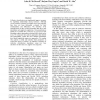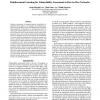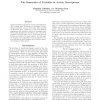115
Voted
AAAI
2007
15 years 3 months ago
2007
Coordinating a group of robots to work in formation has been suggested for a number of tasks, such as urban searchand-rescue, traffic control, and harvesting solar energy. Algorit...
124
Voted
AAAI
2007
15 years 3 months ago
2007
In timed, zero-sum games, the goal is to maximize the probability of winning, which is not necessarily the same as maximizing our expected reward. We consider cumulative intermedi...
104
click to vote
AAAI
2007
15 years 3 months ago
2007
Collective classification can significantly improve accuracy by exploiting relationships among instances. Although several collective inference procedures have been reported, they...
78
Voted
AAAI
2008
15 years 3 months ago
2008
We present preliminary results of using physical features of a user's sketching style, such as pen tilt and pressure, to identify a user from their sketched strokes.
133
Voted
AAAI
2007
15 years 3 months ago
2007
In this paper, we consider a hybrid solution to the sensor network position inference problem, which combines a real-time filtering system with information from a more expensive,...
88
Voted
AAAI
2008
15 years 3 months ago
2008
We consider the problems of sequential prediction and change detection that arise often in interactive applications: A semi-automatic predictor is applied to a time-series and is ...
95
Voted
AAAI
2007
15 years 3 months ago
2007
Existing graph partitioning approaches are mainly based on optimizing edge cuts and do not take the distribution of edge weights (link distribution) into consideration. In this pa...
87
Voted
AAAI
2008
15 years 3 months ago
2008
Proactive assessment of computer-network vulnerability to unknown future attacks is an important but unsolved computer security problem where AI techniques have significant impact...
104
click to vote
AAAI
2007
15 years 3 months ago
2007
Action description language C+ is more expressive than ADL in many ways; for instance, it addresses the ramification problem. On the other hand, ADL is based on first-order logi...
115
Voted
AAAI
2008
15 years 3 months ago
2008
Current search engines cannot effectively rank those relational data, which exists on dynamic websites supported by online databases. In this study, to rank such structured data, ...



